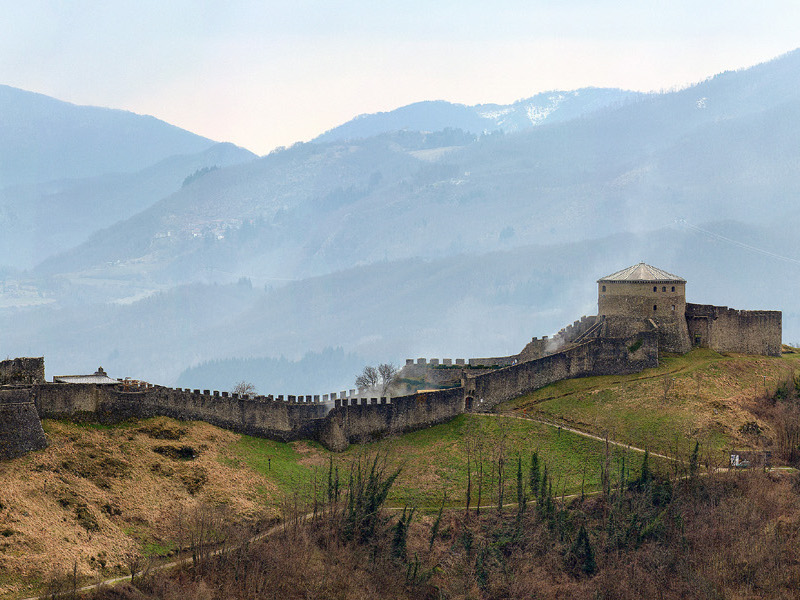castle overview
In describing the most memorable characteristics of the Park's territories, one must not overlook the artifacts of regional cultural heritage that accent the remarkable scenery. Castles can be found in the park, primarily in the regions of Lunigiana and Garfagnana. The castles formerly in existence on the north side of the park are now mostly in ruin.
The Lunigiana region is a veritable land of castles. In the historic past, the territory was divided into many duchies and fiefs - everyone wanted to own a piece of land along the road to Rome. Some of these historic principalities were as big as a couple of villages. All the castles were built for military reasons, but over the centuries some turned into palaces which are still inhabited today. For example, the castle of Verrucole near Fivizzano or the small castles of Monti and Bastia in Lunigiana were converted from fortresses into palaces.
Always check with the visitor center at each destination for opening times, because these can vary over the year.
Castle highlights in the Park
Castle of Camano
Italian Name: Castello di ComanoLocation: Comano (MS)
Region: Tuscany
This medieval fortress located in the upper Taverone River valley is surrounded by pastures, chestnut groves and the Apennine Mountains. Although, archaeologists have found evidence from the site that would indicate inhabitants since Roman times.
The fortress's location helped the surrounding territory to thrive during the Middle Ages since it was positioned to face the major passageways between Tuscany and Emilia-Romagna. Soldiers from the towers could spot the enemy coming from great distances and since the fortress was built primarily with military functions, it could successfully fight off these adversaries.
Today, only the imposing ruins remain, but the tower and the gateway have been recently restored.
Gragnola Castle
Italian Name: Castello di GragnolaLocation: Fivizzano (MS)
Region: Tuscany
The castle, also known as the "Eagle's Castle" dominates the village of Gragnola from the hills. One of the largest castles of Lunigiana still holds its original central tower that was built in the 13th century and the original outer walls that were constructed in the 15th century. Many changes were made in the 16th century by the Malaspina Family, who made it their home until their decline. Now abandoned for centuries, the earthquake of 1929 has compressed the stability and is currently being restored.
Fortunately, before the castle was completely lost, a private individual bought the historic ruins. The restoration project began in 1996. The project manager stated the importance of this restoration being carried out with passion, care, competence and respect for the original form and building materials. Once the restoration is complete and the castle is safe, the castle will be reopened to the public.
Fortress of Verrucole
Italian Name: Fortezza delle VerrucoleLocation: San Romano in Garfagnana (LU)
Region: Tuscany
The fortress is located on the hill overlooking the town of San Romano, Garfagnana. Verrucole is considered the most important medieval vestiges of the area. There are traces of ancient settlements and also numerous Neolithic findings. The territory was originally divided and disputed between two lords, the Bacciano and the more powerful Gherardinghi.
For a very long time the castle lay abandoned and was reduced to a heap of overgrown vegetation. The local municipality feared that the structure would collapse. Following the acquisition of the site by the municipality in 1980, the property is now in a good state of preservation. The remains of the tower and many other parts have all undergone restoration.
Fortress of Minozzo
Italian Name: Rocca di MinozzoLocation: Villa Minozzo (RE)
Region: Emilia-Romagna
The fragmented nature of the structure prevents establishing the exact date the fortress was built. All that is known about the structure is that it acted as an armed bulwark in defense of the Upper Secchia valley. During the 11th century, the fortress was used as residence of the Head of the court and the garrison of soldiers allocated by the Bishop of Reggio.
The fortress held many other purposes as well. At the bottom of the fortress was a prison, that was guarded by two watchtowers: one on Mount Castellino and the other at the bottom of the Mullet township.
Since 1521, the castle has experienced extreme deterioration over the years and became dangerous for people to inhabit. Ultimately the fortress was able to survive and is now going to be preserved. During the rebuilding and renovations of the castle, several archaeological precious items were found and are currently kept in the dungeons of the old town hall in the capital of the town.
Malaspina Castle in Filattiera
Italian Name: Castello Malaspina a FilattieraLocation: Filattiera (MS)
Region: Tuscany
The Filattiera Castle is on two sides of the main square, surrounded by a large garden, once guarded by a moat. The building is almost entirely made of stone, which shows its architecture and history of its time.
The classical superposition of three large halls still remains. The upper one is covered by wooden coffered, the hall on the ground floor holds a walkway, and the mighty central pillar holding four gigantic stone vaults has been restored.
This castle is now privately owned but travelers can arrange a visit. Calls are accepted on Monday morning.
Telephone: (+39) 018-745-7301
http://www.terredilunigiana.com
Verrucola Castle
Italian Name: Castello della VerrucolaLocation: Fivizzano (MS)
Region: Tuscany
The Verrucola Castle is a precious example of medieval architecture. The first documents indicating the existence of the Verrucola Castle date back to 1077. The Emperor Henry IV granted control to the Estensi family. This is of one of the vassals of Matilde. At the dawn of the 12th Century its name was associated with the Bosi family, but numerous dynasties fought for its control, as they were interested in controlling the routes crossing the Apennines nearby. In 1418, Verrucola was the site of a shocking bloodbath; a conspiracy plotted behind the back of the Marquis Bartolomeo Malaspina. He was killed with an axe along with his pregnant wife, his children and servants.
From the end of the 15th Century, the fortress experienced more devastation with an earthquake in 1481 and thus abandoned. In the 17th Century it became a convent for Augustinian nuns. But it was abandoned once again.
Currently, the castle is in excellent condition, thanks to some restoration work carried out by a private artist named Pietro Cascella. Although the castle is privately owned, it is open to the public on Fridays.
Castle of Bastia
Italian Name: Castello della BastiaLocation: Licciana Nardi (MS)
Region: Tuscany
The castle is located in the center of a small suburb of Bastia, towering over the town at 500 meters (1,641 feet) high. It is strategically positioned near an important passageway and road, in the Taverone Valley. The fortress occupied a strategic position and the point forced passage between the regions of Liguria, Tuscany and Emilia-Romagna. This helped strengthen the zone and took advantage of the important road access.
The castle was preserved very well and currently a family resides there, as it is now privately owned. The four round towers are still visible as they were hundreds of years ago. The imposing structure we see today is a quadrangular with cylindrical corner towers and a central keep. Its last noble owner was the beautiful woman, Anna Malaspina.
Other castles, towers and ancient castle ruins
Castle of Bagnone
Italian Name: Castello di BagnoneLocation: Bagnone (MS)
Region: Massa Carrara
Castle of Bacciano
Italian Name: Castellaccio di BaccianoLocation: San Romano in Garfagnana (LU)
Region: Tuscany
Castle of Bosco Rossi
Italian Name: Castello dei Rossi di Bosco
Location: Corniglio (PR)
Region: Emilia-Romagna
Castle of Scalelle
Italian Name: Castello delle Scalelle
Location: Villa Minozzo (RE)
Region: Emilia-Romagna
Castle of Castelnovo ne' Monti
Italian Name: Castello di Castelnovo Nè Monti
Location: Castelnovo ne' Monti (RE)
Region: Emilia-Romagna
Castle of Corniglio
Italian Name: Castello di Corniglio
Location: Corniglio (PR)
Region: Emilia-Romagna
Licciana Nardi Castle
Italian Name: Castello di Licciana Nardi
Location: Licciana Nardi (MS)
Region: Tuscany
Castle Mountains
Italian Name: Castello di Monti
Location: Licciana Nardi (MS)
Region: Tuscany
Pontebosio Castle
Italian Name: Castello di Pontebosio
Location: Licciana Nardi (MS)
Region: Tuscany
Castle Terrarossa
Italian Name: Castello di Terrarossa
Location: Licciana Nardi (MS)
Region: Tuscany
Blockhouse Sparavalle
Italian Name: Fortino di Sparavalle
Location: Busana (RE)
Region: Emilia-Romagna
Towers of Gova
Italian Name: Torrione di Gova
Location: Villa Minozzo (RE)
Region: Emilia-Romagna










